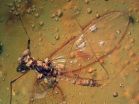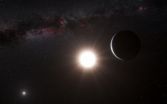(Press-News.org) SANTA CRUZ, CA--Among the oddities of the outer solar system are the middle-sized moons of Saturn, a half-dozen icy bodies dwarfed by Saturn's massive moon Titan. According to a new model for the origin of the Saturn system, these middle-sized moons were spawned during giant impacts in which several major satellites merged to form Titan.
Erik Asphaug, professor of Earth and planetary sciences at the University of California, Santa Cruz, will present this new hypothesis October 19 at the annual meeting of the Division for Planetary Sciences of the American Astronomical Society in Reno, Nevada. Asphaug and his coauthor, Andreas Reufer of the University of Bern, Switzerland, also describe their model in detail in a paper to be published in Icarus (in press).
Asphaug and Reufer propose that the Saturn system started with a family of major satellites comparable to the four large moons of Jupiter (known as the Galilean moons, discovered by Galileo in 1610). The Galilean moons account for 99.998 percent of the mass in Jupiter's satellite system; although it has dozens of small satellites, Jupiter has no middle-sized moons. The new model may explain why the two systems are so different.
"We think that the giant planets got their satellites kind of like the Sun got its planets, growing like miniature solar systems and ending with a stage of final collisions," Asphaug said. "In our model for the Saturn system, we propose that Titan grew in a couple of giant impacts, each one combining the masses of the colliding bodies, while shedding a small family of middle-sized moons."
Earth is thought to have undergone a similar kind of giant impact, in which our planet gained the last ten percent of its mass and spawned the moon. Just as our moon is thought to be made out of material similar to Earth's rocky mantle, the middle-sized moons of Saturn are made of material similar to Titan's icy mantle, Asphaug said.
"Our model explains the diversity of these ice-rich moons and the evidence for their very active geology and dynamics," he said. "It also explains a puzzling fact about Titan, in that a giant impact would give it a high orbital eccentricity."
Asphaug and Reufer used computer simulations to study the giant impact scenario, and they found that mergers of satellites the size of the Galilean moons can liberate ice-rich spiral arms, mostly from the outer layers of the smaller of the colliding moons. Gravitational clumping of the spiral arms then leads to the formation of clumps with sizes and compositions that resemble Saturn's middle-sized moons.
"These satellite collisions are a regime that is not very well understood, so the modeling opens up new possibilities in general for planet formation," Reufer said.
The proposed mergers might have occurred as the final act in the process of satellite formation. Alternatively, Saturn may have had a stable system of Galilean-like satellites that was later disrupted by the possibly chaotic migration of the giant planets, as described in the popular "Nice model" of the solar system. A late origin has the advantage of explaining some of the most striking features of the Saturn system.
"What makes the Saturn system so beautiful and unique could be its youth," Asphaug said. "While we don't have a preferred timeframe for this origin scenario to play out, it could have happened recently if something came along to destabilize the Saturn system, triggering the collisional mergers that formed Titan. This 'something' could have been the close passage of a marauding Uranus and Neptune, which is part of the Nice model."
Asphaug acknowledged a couple of dynamical issues raised by the new model. The clumps spawned from the giant impacts might get swept up into the accretion of Titan, rather than evolving into separate moons with their own stable orbits. Additional simulations of the dynamical evolution of the complicated, accreting system are needed to further explore and validate the model. But Asphaug said new data from NASA's Cassini mission on the geophysics of Saturn's moons will provide the ultimate tests.
"Our model makes strong predictions for how Titan was assembled, what the middle-sized moons are made of, and how they started out as rapidly spinning clumps of ice-rich material," he said. "So it's testable. These little moons could provide the clues telling us what happened, and when."
###
This research was funded by NASA, the University of California, and the Swiss National Science Foundation.
Giant impact scenario may explain the unusual moons of Saturn
2012-10-18
ELSE PRESS RELEASES FROM THIS DATE:
The evolutionary origins of our pretty smile
2012-10-18
It takes both teeth and jaws to make a pretty smile, but the evolutionary origins of these parts of our anatomy have only just been discovered, thanks to a particle accelerator and a long dead fish.
All living jawed vertebrates (animals with backbones, such as humans) have teeth, but it has long been thought that the first jawed vertebrates lacked pearly gnashers, instead capturing prey with gruesome scissor-like jaw-bones.
However new research, led by the University of Bristol and published today in Nature, shows that these earliest jawed vertebrates possessed teeth ...
Epigenetic analysis of stomach cancer finds new disease subtypes
2012-10-18
DURHAM, N.C. – Researchers at the Duke-NUS Graduate Medical School in Singapore have identified numerous new subtypes of gastric cancer that are triggered by environmental factors.
Reported in the Oct. 17, 2012, issue of the journal Science Translational Medicine, the findings are based on the science of epigenetics, a study of gene activity. The insights into the complexities of stomach cancer could lead to better treatment approaches for the second leading cancer killer in the world, behind lung cancer.
"Gastric cancer is a heterogenous disease with individual patients ...
Physical activity shown to help young and elderly alike with lower-leg coordination
2012-10-18
An Indiana University study that examined the effect of age and physical activity on lower leg muscle reflexes and coordination concluded that participation in physical activity was beneficial for lower leg muscle coordination across both sides of the body in both young and older study participants. Lower limb muscle communication is essential for everyday tasks, such as walking, balancing, and climbing stairs.
"The results of this study suggest that participation in physical activity contributes to greater crossed-spinal reflex stability in both young and elderly subjects," ...
Springtail bugs may have travelled on the wings of mayflies
2012-10-18
A mayfly trapped in 16-million-year-old-amber reveals a hitchhiking springtail, a wingless arthropod that is amongst the most commonly found bugs all over the world. The new research, published Oct 17 in the open access journal PLOS ONE led by David Penney from the University of Manchester, UK, is the first to show that springtails travelled on winged insects like mayflies, and only the second example of this mode of travel by springtails in the past or present.
Springtails are among the most abundant group of arthropods, found in large numbers in soil all over the world. ...
Dolphins can remain alert for up to 15 days at a time with no sign of fatigue
2012-10-18
Dolphins sleep with only one half of their brains at a time, and according to new research published Oct. 17 in the open access journal PLOS ONE, this trait allows them to stay constantly alert for at least 15 days in a row. Brian Branstetter from the National Marine Mammal Foundation and colleagues found that dolphins can use echolocation with near-perfect accuracy continuously for up to 15 days, identifying targets and monitoring their environment.
The researchers studied 2 dolphins, one male and one female, and found that they were capable of this task with no signs ...
Impact of autism may be different in men and women
2012-10-18
Men and women with autism spectrum conditions (ASC) may show subtle but significant differences in the cognitive functions impacted by the condition, according to new research published Oct 17 by Meng-Chuan Lai and colleagues from the Autism Research Centre at the University of Cambridge, UK in the open access journal PLOS ONE.
Though individuals with autism show sex-specific differences in serum biomarkers, genetics and brain anatomy, little is known about any sex-dependent differences in cognition caused by ASC. Following their previous report on behavioral sex differences ...
Children with autism can identify misbehavior but have trouble putting it in words
2012-10-18
Children with autism have difficulty identifying inappropriate social behavior, and even when successful, they are often unable to justify why the behavior seemed inappropriate. New brain imaging studies show that children with autism may recognize socially inappropriate behavior, but have difficulty using spoken language to explain why the behavior is considered inappropriate, according to research published Oct. 17 in the open access journal PLOS ONE by Elizabeth Carter from Carnegie Mellon University and colleagues.
The authors say the results of their functional ...
Crows don't digest prions, may transport them to other locations
2012-10-18
Crows fed on prion-infected brains from mice can transmit these infectious agents in their feces and may play a role in the geographic spread of diseases caused by prions, such as chronic wasting disease or scrapie. The new research published Oct. 17 in the open access journal PLOS ONE by Kurt VerCauteren from the US Department of Agriculture (USDA) and other colleagues, shows that prions can pass through crows' digestive systems without being destroyed, and may be excreted intact after ingestion by the birds. According to the authors, their results demonstrate a potential ...
Planet found in nearest star system to Earth
2012-10-18
European astronomers have discovered a planet with about the mass of the Earth orbiting a star in the Alpha Centauri system — the nearest to Earth. It is also the lightest exoplanet ever discovered around a star like the Sun. The planet was detected using the HARPS instrument on the 3.6-metre telescope at ESO's La Silla Observatory in Chile. The results will appear online in the journal Nature on 17 October 2012.
Alpha Centauri is one of the brightest stars in the southern skies and is the nearest stellar system to our Solar System -- only 4.3 light-years away. It is ...
Women whose first pregnancy was ectopic have fewer children
2012-10-18
Women whose first pregnancy is ectopic are likely to have fewer children in the following 20-30 years than women whose first pregnancy ends in a delivery, miscarriage or abortion, according to results from a study of nearly 3,000 women in Denmark. In addition, these women have a five-fold increased risk of a subsequent ectopic pregnancy.
The first study to look at long-term reproductive outcomes in women whose first pregnancy was ectopic is published online today (Thursday) in Europe's leading reproductive medicine journal Human Reproduction [1].
Ectopic pregnancies ...


